
차광형태와 기간이 천궁의 고온피해 경감에 미치는 효과
This is an open access article distributed under the terms of the Creative Commons Attribution Non-Commercial License (http://creativecommons.org/licenses/by-nc/3.0/) which permits unrestricted non-commercial use, distribution, and reproduction in any medium, provided the original work is properly cited.
Abstract
Cnidium officinale is a medicinal crop sensitive to high temperature. It is necessary to develop environment control technology that can reduce environmental stresses such as high temperature. This study was conducted to develop technology for stable production of Cnidium officinale by reducing damage owing to high temperature by applying shading treatment of varying duration, and structure.
Black shading nets were used from May to September or November; shading structures such as pillar, flat roof, and tunnel type structures were installed. Environmental changes, rate of photosynthesis, and growth characteristics were investigated. The shading treatment reduced temperature by 3℃. The rate of photosynthesis and yield with shading treatment were higher by 134% and 127%, respectively, than those with full sunlight. The ratio of shading area ranged from 50% to 71% according to the type of shading structure. The effect of environmental control on growth varied depending on the type of shading structure.
The shading treatment reduced damage owing to high temperature, shading rate of 55% - 75% was recorded between the period May - September, and the flat roof type shading structure was considered the most suitable among shading methods.
Keywords:
Cnidium officinale, Heat Stress, Photosynthesis, Shading서 언
천궁 (Cnidium officinale Makino)은 근경을 한약재로 사용하는 산형과의 다년생 식물이다. 2017년 기준 전국 재배면적은 185 ㏊, 총 생산량은 1,290 M/T 정도이며, 경상북도가 전국 재배면적의 94%를 차지하고 있다. 최근 건강기능식품, 화장품 소재 등으로 천궁의 활용이 증가됨에 따라 국내 생산량만으로는 수요를 충족할 수 없는 실정이다. 농림축산식품부에 따르면 최근 수입 검역량은 2016년 799 M/T, 2017년 610 M/T, 2018년 558 M/T으로 많은 부분을 수입에 의존하고 있다 (MAFRA, 2018).
천궁의 재배적지는 최고온도 30℃ 이하의 서늘한 지역으로 2010년 기준 전 국토의 3% 정도만이 이에 해당된다 (RDA, 2014). 또한 최근의 기후 변화에 따른 온난화 현상으로 재배적지가 꾸준히 감소할 것으로 전망되고 있으며, 더욱이 이상기상에 따른 고온으로 농가에서 재배에 어려움을 겪고 있다. 대부분의 약용작물이 농경지 재배환경 하에서는 높은 일사와 고온에 의해 생육 저해가 발생하는데 특히 천궁은 잎 두께가 얇아 온도, 수분과 같은 환경요인에 대한 저항성이 낮은 식물이다 (Kim et al., 2013).
노지에서 고온피해를 저감하기 위한 환경조절의 일차적인 목표는 일사 등에서 유래하는 유입 에너지의 총량을 제한하는 것이다. 그 대책으로 차광, 적지 재배, 간작, 관수 등의 재배적 요인에 의한 방법들이 보고되어 왔다. 대표적으로 인삼 재배시설은 일사량의 90% 이상을 차단하며 (Jang et al., 2019) 눈개승마 (Lee et al., 2019), 삼채 (Kim et al., 2017) 등에서도 자생환경의 재현을 위해 차광처리에 따른 생리적 특성변화가 연구되었다. 천궁에 있어서도 차광재료, 차광률에 따른 생육반응을 검토한 바 있으나 (Choi et al., 2000) 전 생육기간 중 차광에 따른 광합성률, 증산률 등의 생육특성에 대한 연구는 미흡한 실정이다.
유입에너지의 대부분을 차지하는 일사량과 관련하여 시설물의 구조 설계에서는 일사데이터를 활용한 차광 효율이 광범위하게 분석되고 있으며, 시설재배에서도 구조물에 의한 수광효율, 스크린, 도포제 등에 의한 차광효과 등이 검토되고 있으나 (Ahemd et al., 2016; Mahmood et al., 2018; Rafiq et al., 2019) 노지 차광시설에 대한 구조 평가는 미흡하다. 더욱이 농업분야에서 차광구조물의 이미지 분석을 통한 차광효율 평가 는 전무한 실정이다.
따라서 본 연구는 기후변화의 영향으로 주산지를 비롯한 여러 재배지역에서 천궁의 고온피해가 증가하여 재배 안정성이 심각하게 취약해지고 있는 상황에서 고온피해를 경감하기 위한 기초자료를 확보하고자 생육기간 중 차광시기에 대한 효과를 분석하고 시설형태별 차광면적을 모의실험한 후 실제 재배조건에서 생육환경과 생육특성에 미치는 영향을 조사하였다.
재료 및 방법
1. 시험장소 및 재배법
차광기간에 따른 차광효과 구명을 위한 천궁 (Cnidium officinale Makino)의 재배는 2018년 경상북도 안동시 예안면의 재배포장 (36◦43′34″N 128◦55′58″E)에서 수행하였다. 토양통은 고천 (Gz)이었으며 2018년 4월 5일에 영양재래종을 정식하였다. 차광 시설형태별 차광효과 시험은 2019년에 경상북도 안동시 예안면의 재배포장 (36◦42′25″N 128◦55′40″E)에서 수행하였다. 토양통은 풍천 (Pu)이었으며, 2019년 3월 28일에 영양재래종을 정식하였다. 폭 80 ㎝ - 90 ㎝의 이랑과 40 ㎝ - 50 ㎝의 고랑을 조성하여 흑색 비닐을 피복한 후 1 휴 2 열로 정식하였고 기타 재배법은 농촌진흥청 표준재배법 (RDA, 2010a)에 준하여 실시하였다.
2. 차광기간별 효과 분석
고온피해 경감을 위한 차광효과 및 차광기간의 영향을 구명하기 위하여 2018년 5월 11일에 폭 6 m, 높이 3 m, 길이 30 m의 아치형 하우스를 설치한 뒤 75% 흑색 차광망을 같은 해 9월 12일 (차광 1) 또는 11월 5일 (차광 2)까지 피복하여 무처리와 비교하였다.
처리별 환경조건은 온습도기록계 (HOBO MX2302, ONSET Co., Bourne, MA, USA), 조도계 (SpectraPen LM520, Photon Systems Instruments Co., Drasov, Czech)를 사용하여 조사하였다. 또한 차광 46 일, 96 일 후에 휴대용 광합성측정기 (LI-6400XT, LI-COR Inc., Lincoln, NE, USA)를 사용하여 광합성을 측정하였고 조건은 CO2 400 μ㏖·㏖-1, flow rate 500 μ㏖·s-1, light 800 μ㏖·m-2·s-1로 설정하였다. 6월 25일, 9월 5일, 11월 5일에 초장, 엽수 등 지상부 생육과 근장, 근경중 등 지하부 생육특성을 조사하였다.
3. 시설 형태별 차광효과 분석
시설 형태에 따른 차광효과를 알아보기 위한 시험은 모의실험과 실제 재배시험을 병행하였다. 모의실험은 3D 모델링 프로그램 (Sketchup, Trimble Inc., Sunnyvale, CA, USA)을 이용하였고 시험포장 (36◦42′25″N 128◦55′40″E)에서 남북방향으로 폭 3 m, 높이 1.5 m의 지주형 (I), 텐트형 (∏), 아치형 (∩)의 시설물을 대상으로 하였으며 (Fig. 4) 2019년 6월에서 9월의 일조조건하에서 차광면적을 모의실험하였다. 차광구조물을 포함한 지표면 12 m × 12 m 면적에서의 그림자 면적을 이미지분석소프트웨어 (Photoshop, Adobe Inc., San Jose, CA, USA; ImageJ, National Institutes of Health, Bethesda, MD, USA)를 사용하여 산출하였으며 전체 면적 대비 그림자 면적의 비율을 차광면적률로 계산하여 각 시설구조의 효율을 평가하였다.
모델을 통해 분석된 구조물을 2019년 6월 10일에 시험포장내에 설치하고 55% 흑색 차광망을 9월 24일까지 피복하였다. 차광기간별 효과 시험과 같이 생육환경, 생리반응, 생육특성을 조사하였다. 차광시설의 농가적용성을 검토하기 위하여 형태별 경제성 분석을 부분예산법 (RDA, 2010b)에 따라 실시하였다. 재료비는 실제 투입된 비용으로 산정하였고 인건비는 2019년도 정부노임단가 (일반인부) 기준이며 천궁 건근가격은 대구한약재도매시장에서 2015년 - 2017년에 거래된 평균가격을 사용하였다.
4. 통계분석
재배시험은 완전임의배치법 3 반복으로 실시하였고 통계분석은 R (v3.4.4), Sigmaplot 14.0 (SYSTAT Software Inc., San Jose, CA, USA)을 이용하여 5%의 유의수준에서 Duncan’s Multiple Range Test (DMRT, p < 0.05)를 이용하여 검정하였다.
결과 및 고찰
1. 차광 처리기간에 따른 재배환경 변화
2018년 5월 21일 14:00, 8월 14일 12:30, 9월 5일 16:30에 측정한 차광처리에 의한 일사량의 감소는 Fig. 1과 같았다. 무처리 대비 광량은 각각 25.2%, 31.9%, 19.5% 수준이었고 630 ㎚ - 670 ㎚의 적색광 영역에서 상대적으로 감소율이 컸다.

Spectral qualities of sunlight as affected by shading treatment during growth period of Cnidium officinale in 2018.A; 14:00, May 21, B; 12:30, Aug. 16, C; 16:30, Sep. 5.
차광에 의한 일사량 감소로 5월에서 9월까지 생육기간 동안 낮 (06시 - 18시) 평균기온이 3℃ 정도 낮아지는 효과가 있었다 (Table 1). 차광에 의한 재배환경의 조절은 재배지역 및 차광방법에 따라 편차가 발생하지만 노지에서는 고온기 기온을 2℃ - 3℃ 정도 낮출 수 있다는 보고와 일치하였다 (Ahemd et al., 2016; Kim et al., 2017). 한편 근경비대기인 9월에서 11월의 차광은 낮 평균기온을 1.3℃ 가량 낮추었으며, 야간 (00시 - 06시)의 온도 변화는 차광처리에 따른 차이를 관찰할 수 없었다.
천궁 (Cnidium officinale Makino)은 흑구온도 기준 45 ℃ 이상에서 생육이 정지되고 고사증상이 나타나며 (Seo et al., 2018), 낮 대기온도 기준으로 28℃ 이상이 3 일 이상 지속될 경우 고온피해가 발생하기 시작하는데, 본 연구에서는 시험기간 중 한계온도를 초과하는 빈도수는 무차광 59 일에 비해 차광처리에서 30 일로 19 일이 줄었다. 따라서 차광에 따른 고온피해 경감을 기대할 수 있을 것으로 판단된다.
2. 차광 처리기간에 따른 천궁의 광합성 반응
75% 차광 46 일, 96 일 후인 6월 25일과 8월 14일의 천궁의 광합성 반응은 Fig. 2와 같다. 무차광과 비교하여 차광 46 일 후의 광합성률, 기공전도도, 증산률 등은 각각 34%, 91%, 64% 증가한 반면 잎 증기압차, 엽온, 수분이용효율은 각각 18%, 6%, 22% 감소하였다. 이와 같은 차광효과는 고온기인 8 월에 더욱 증가하는 경향이었으며 특히 광합성률이 무차광 4.7 μ㏖·m-2·s-1, 차광 11.0 μ㏖·m-2·s-1로 2.3 배 높았다. 또한 기공전도도와 증산률은 각각 548%, 185% 증가하였고 잎 증기압, 엽온, 수분이용효율은 각각 50%, 20%, 18% 감소하였다.
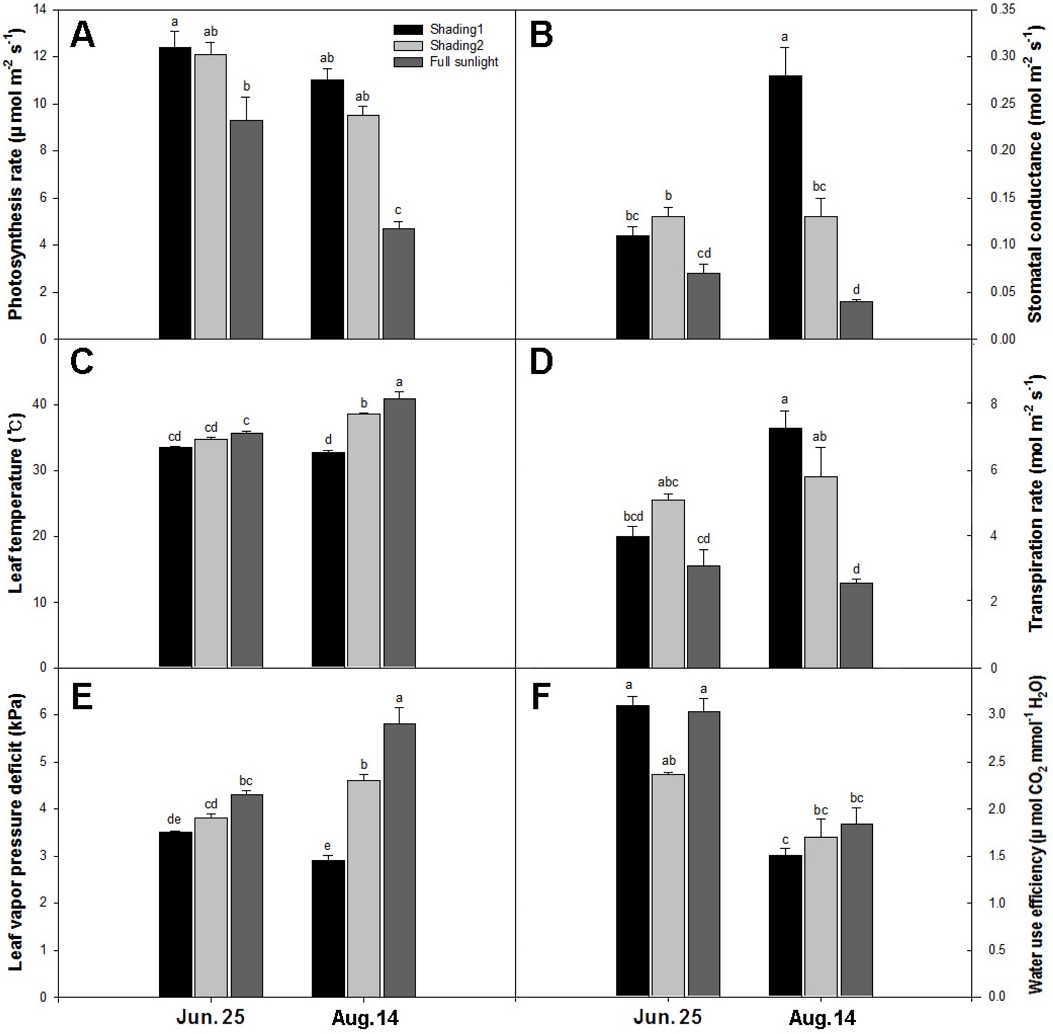
Photosynthetic characteristics of Cnidium officinale as affected by shading duration.Shading 1; shading from May 21 to Sep. 12, Shading 2; shading from May 21 to Nov. 5. *Means with different letters are significantly different at the 5% level by Duncan’s Multiple Range Test (DMRT, p < 0.05).
식물은 고유의 형태적, 생리적 특성에 따라 광환경에 적응하게 되는데 대부분의 약용작물들은 광보상점이 낮고 순양자수율이 높은 음지식물의 특성을 보인다 (Kim and Lee, 2001). 하지만 광 환경에 따라 작물의 생리생태적 반응은 특이적으로 발현되며 수리취 (Lee et al., 2012a), 벌개미취 (Nam et al., 2016) 등의 양지식물들은 차광수준이 높을수록 광합성 활성이 낮아지고 잎이 커지면서 비엽중이 감소하는 형태적 특성을 보인 반면 병풍쌈은 무차광에서 낮은 광합성 활성을 보이는 등 (Lee et al., 2012b) 음지식물의 특성을 나타내었다. 동일한 작물에서도 강광조건에 적응된 잎은 두꺼워지고 최대 광합성속도가 높아지면서 동시에 호흡속도도 증가하는 반응을 보인다. 반면 약광조건에 적응된 잎은 비엽중이 감소하고 약광조건에서 양자수율이 증가하는 반응을 보이게 되는데 (Kim and Lee, 2001) 고온장해 경감을 목적으로 차광처리를 실시할 경우 대상 작물의 저광도 적응 여부를 고려해야 한다. 천궁은 본 실험에서와 같이 고온조건에 민감한 생리생태적 특성을 보였으며 차광조건에서 무차광에 비해 광합성률과 기공전도도 등 생리 활성이 높게 유지되는 음지식물의 특성을 보이는 것을 확인하였다.
3. 차광 처리기간에 따른 천궁의 생육특성 변화
차광처리에 따른 천궁의 생리활성 변화는 다음과 같은 생육특성의 변화를 초래하였다. 차광 개시 후 46 일 (6월 25일)과 118 일 (9월 5일) 조사 결과 초장은 무처리에 비해 각각 21%, 56% 더 컸으며 (Fig. 3A), 무처리의 지상부 건물중은 차광처리 대비 33% 수준에 머물렀다 (Fig. 3D). 근경직경, 지하부 건물중과 같은 지하부 생육특성은 차광 후 118 일의 조사결과 유의한 차이를 보이지 않았지만 (Fig. 3C, 3E) 수확기인 11월 5일 조사결과에서 차광 1 (5월 11일 - 9월 12일) > 차광 2 (5월 11일 - 11월 5일) > 무차광의 순으로 많았으며 (Fig. 3D, 3F) 근경 비대기인 9월 5일부터 11월 5일까지의 건물중 증가속도는 차광 1, 차광 2, 무차광 각각 1.03 g/day, 0.48 g/day, -0.04 g/day을 보여 (Fig. 3E) 근경비대기에 차광하는 것은 지하부 생장에 부정적인 영향을 미치는 것으로 보인다. 이는 천궁의 근경 비대특성에서 기인하는 것으로서 천궁의 근경은 8월에서 9월까지 형성되어 9월 이후 비대되기 시작하므로 근경 형성기의 차광은 source의 형성 및 유지에 영향을 주는 것으로 보인다.
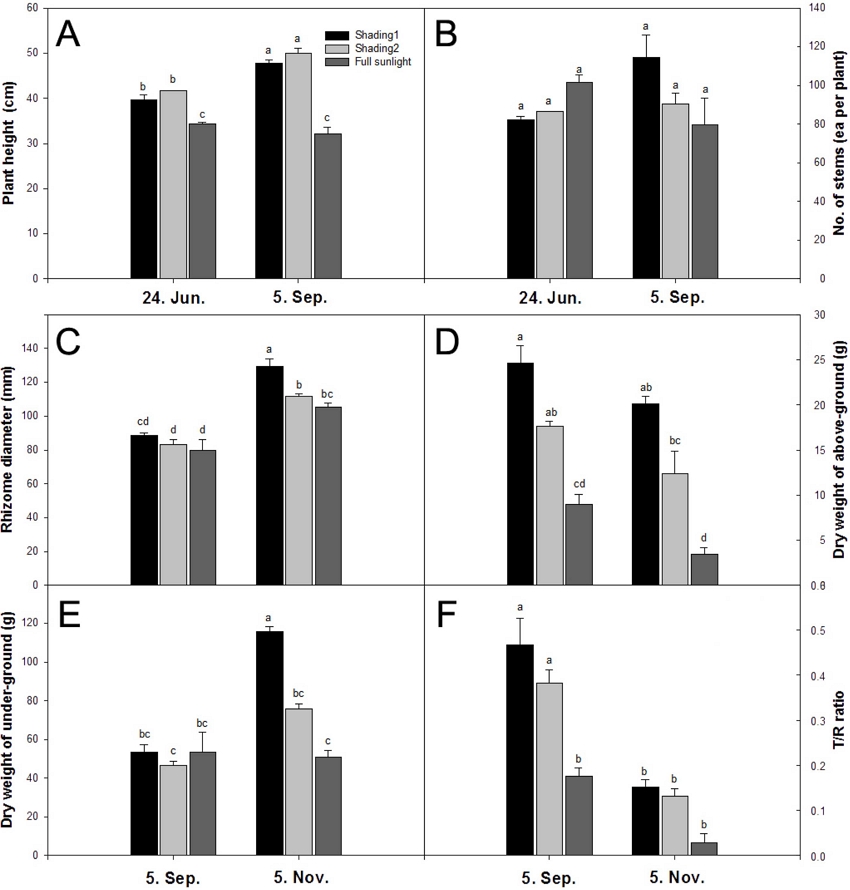
Growth characteristics of Cnidium officinale as affected by shading duration.Shading 1; shading from May 21 to Sep. 12, Shading 2; shading from May 21 to Nov. 5. *Means with different letters are significantly different at the 5% level by Duncan’s Multiple Range Test (DMRT, p < 0.05).
따라서 천궁의 고온피해를 경감하기 위해 차광을 실시하는 것은 생육환경을 조절함으로써 생리활성을 유지할 뿐 아니라 근경 건물중과 같은 농업적 형질의 감소를 막을 수 있는 유효한 방법으로 판단된다.
4. 차광시설물의 형태별 차광면적 효과
차광시설물의 형태별 효과를 모의실험하기 위하여 Fig. 4와 같은 형태의 구조를 대상으로 고온기인 6월부터 9월까지 10일 간격으로 차광면적을 산출하였다 (Fig. 5).
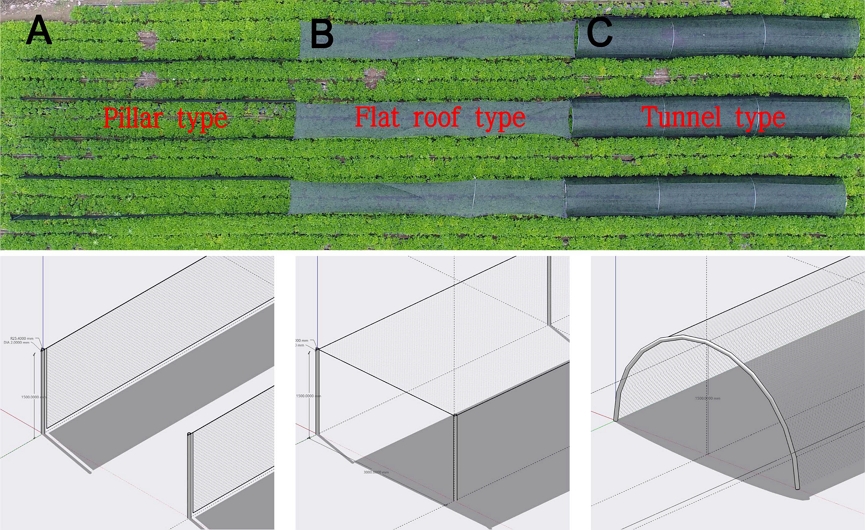
Types of shading installation to reduce high temperature stress in Cnidium officinale.A; pillar type, B; flat roof type, C; tunnel type.
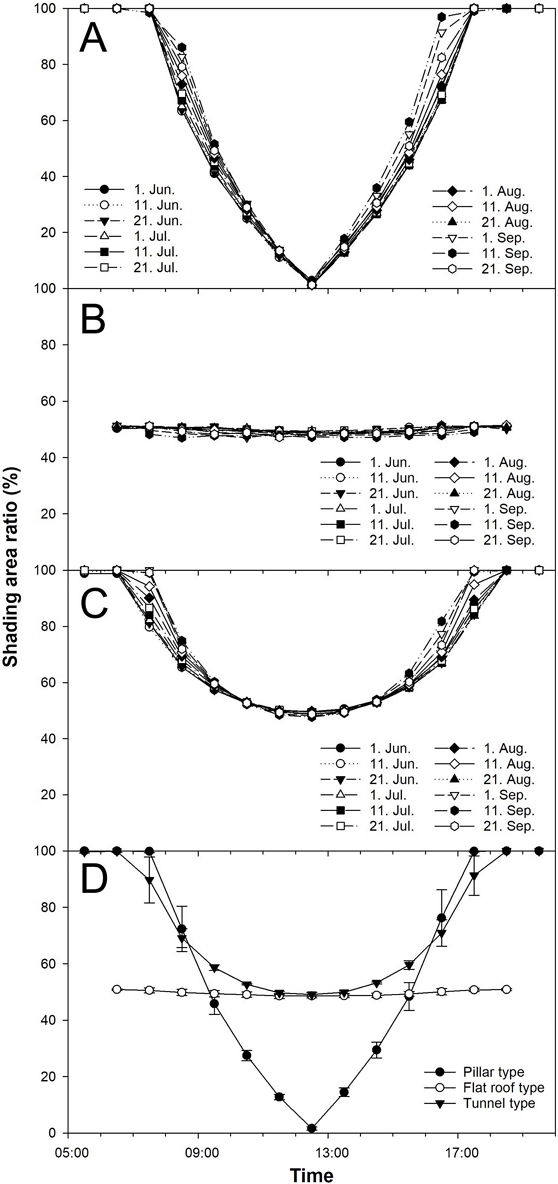
Changes of estimated shading area ratio according to shading installation types from July to September in 2019.A; pillar type, B; flat roof type, C; tunnel type. D; average shading area ratio of three types.
평균 차광면적률은 터널형 70.8%, 지주형 58.8%, 텐트형 49.6%의 순으로 많았다. 차광시설물 형태별, 시간대별 차광특성을 살펴보면, 지주형은 다른 구조에 비해 일출 후, 일몰 전차광면적이 높았으나 일중 온도가 가장 높은 12시에서 14시 사이에 차광효율이 낮아 고온경감 효과가 떨어질 것으로 판단되었다. 텐트형의 경우 상단부 차광망의 크기와 동일한 차광면적이 지속됨에 따라 가장 낮은 차광면적률을 보였으나 일중온도가 가장 높은 시간대에는 차광상태를 유지하면서 일출, 일몰 시기에는 충분한 일사량을 공급하게 되므로 생육에 좋은 영향을 미칠 것으로 예상되었다. 터널형은 구조물 하단이 하루 종일 일사가 차단되었고 태양 고도에 따라 구조물 사이의 그림자 면적이 변동하게 되므로 가장 높은 차광면적률을 보인 반면 광합성이 활발히 일어나는 일출 전후의 광량도 감소시키는 단점이 있었다.
5. 차광시설물의 형태별 온도 변화
모의실험을 통해 차광효율을 분석한 구조물을 실제 시험포장에 설치한 뒤 7월 중 온도환경을 측정한 결과, 무처리에 비해 차광처리의 기온은 일평균, 7, 14, 19시에 각각 0.7℃ - 1.6℃, 0.4℃ - 0.7℃, 0.2℃ - 3.2℃, 0.1℃ - 0.6℃ 정도 낮았고 (Table 2), 2019년 7월 23일 오후 15시 기준 군락의 온도 분포에서도 무처리, 지주형, 텐트형, 터널형 각각 최고온도 32.7℃, 31.4℃, 30.6℃, 30.7℃로 1.3℃ - 2.6℃ 낮았다 (Fig. 6).
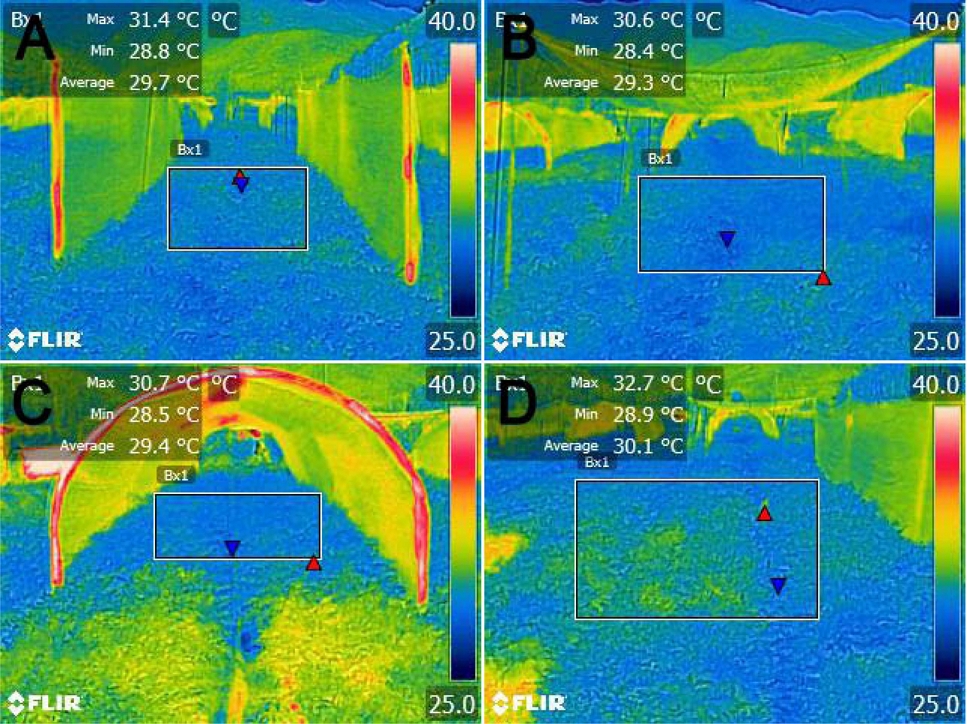
Temperature distribution of canopy of Cnidium officinale as affected by shading installation types at 15:00, Jul. 23 in 2019.A; pillar type, B; flat roof type, C; tunnel type, D; full sunlight.
지주형은 타 처리에 비해 최저기온이 낮은 반면 14시에는 무처리와 온도 차이를 보이지 않았다. 터널형은 온도 강하가 가장 크게 나타났으나 최저온도와 17시의 기온이 무처리와 큰 차이를 보이지 않았다. 이는 차광망이 낮 동안 흡수한 에너지를 야간에 방출하였기 때문으로 보이며 차광소재에 따른 에너지의 흡수, 복사와 관련된 추가적인 검토가 필요하다고 판단된다. 텐트형은 구조효율 분석시 가장 낮은 차광면적률을 보였으나 고온기 군락내 온도 저하정도는 터널형과 큰 차이를 보이지 않았다.
6. 차광시설물의 형태별 천궁의 광합성 및 생육반응
고온기 광합성 반응은 차광효과 시험과 같이 차광처리가 광합성률 31% - 45%, 순양자수율 2% - 17% 더 높아진 반면 잎 증기압차와 엽온과 같은 고온반응은 감소하였으며 구조물 형태에 따라서는 텐트형 > 터널형 > 지주형의 순으로 고온환경 경감 및 생리활성 개선효과를 보였다 (Table 3). 생육특성은 Table 4와 같이 차광 개시 48 일 후인 7월 27일은 유의 한 생육량의 차이를 보이지 않았으나 148 일 후인 11월 4일은 텐트형의 근경 직경과 건물중이 150 ㎜, 169.5 g으로 무처리 대비 각각 14.5%, 10.1% 증가하였다.
이와 같은 결과는 모의실험 결과와 일치하였으며, 텐트형은 고온시간대에는 온도를 낮추고, 저온시간대에는 일정한 일사를 공급하는 구조인 것으로 판단된다. 이는 일사가 일정량까지 증가함에 따라 증산률은 증가하는 반면, 임계점을 초과할 때는 엽온 상승 등에 따른 생육 불량 현상을 초래한다는 보고 (Seo et al., 2019)와도 일치하였다. 한편, 차광기간별 차광효과 시험과 비교하여 차광효과가 감소하였는데, 이는 연차 간 고온 환경의 차이에서 기인하는 것으로 보인다. 추후 다양한 고온 환경조건에서의 환경 및 생리활성 개선 효과를 밝히는 것과 함께 유효성분 등 품질의 변화를 구명할 필요가 있을 것으로 판단된다.
천궁 차광재배의 농가 수용가능성을 검토하기 위하여 텐트형 시설물의 경제성을 부분예산법에 따라 분석한 결과 손실적 요소는 재료비 349 천원, 인건비 391 천원로써 총 740 천원이 발생한 반면 이익적 요소는 건근 수량 증가로 1,522 천원 (72 ㎏ × 12,681 원/600g)이 발생하여 경제적 효과는 10 a 당 782 천원 정도로 추정되었다.
이상의 결과 천궁의 고온기 차광처리의 효과는 기온과 엽온을 낮춰 생리활성을 유지하며, 정상적인 생육이 가능하도록 하는 등 고온피해 경감의 현실적 해결 방안으로 보인다. 또한 구조물 형태에 따라 효과의 차이가 있으나 간이 텐트형 구조가 차광효과, 설치 및 재배관리의 용이성을 고려할 때 농가 현장에서 적용 가능한 차광기술로 판단되었다.
Acknowledgments
본 연구는 농촌진흥청 연구사업(과제번호: PJ01482005)의 지원에 의해 이루어진 결과로 이에 감사드립니다.
References
-
Ahemd HA, Al-Faraj AA and Abdel-Ghany AM. (2016). Shading greenhouses to improve the microclimate, energy and water saving in hot regions: A review. Scientia Horticulturae. 201:36-45.
[https://doi.org/10.1016/j.scienta.2016.01.030]

- Choi SY, Chang KJ, Lee KC and Park CH. (2000). Effects of mulching and shading on growth and yield of Ligusticum chuangxion HORT. and Cnidium officinale MAKINO. Korean Journal of Medicinal Crop Science. 8:209-215.
-
Jang IB, Moon JW, Yu J, Jang IB, Suh SJ and Chun CH. (2019). Analysis of microclimate response and high-temperature injury in ginseng as affected by shading. Korean Journal of Medicinal Crop Science. 27:278-283.
[https://doi.org/10.7783/KJMCS.2019.27.4.278]

- Kim JC, Jang WC, Son HR, Seo YJ, Lee JP and Park HR. (2013). Medicinal plants in living. Daechangsa. Daegu, Korea. p.360-361.
-
Kim MH, Song BM and Choi EY. (2017). Determination of growth, yield and carbohydrate content of Allium hookery grown under shading treatment. Korean Journal of Medicinal Crop Science. 25:397-403.
[https://doi.org/10.7783/KJMCS.2017.25.6.397]

- Kim PG and Lee EJ. (2001). Ecophysiology of photosynthesis 2: Adaptation of the photosynthetic apparatus to changing environment. Korean Journal of Agricultural and Forest Meteorology. 3:171-176.
-
Lee KC, Han SK, Kwon YH. Jeon SR, Lee CW, Seo DJ and Park WG. (2019). Effects of shading treatments on growth and physiological characteristics of Aruncus dioicus var. kamtschaticus (Maxim.) H. Hara Seedling. Korean Journal of Medicinal Crop Science. 27:30-37.
[https://doi.org/10.7783/KJMCS.2019.27.1.30]

-
Lee KC, Lee HB, Park WG and Han SS. (2012a). Physiological response and growth performance of Parasenecio firmus under different shading treatments. Korean Journal of Agricultural and Forest Meteorology. 14:79-88.
[https://doi.org/10.5532/KJAFM.2012.14.2.079]

- Lee KC, Noh HS, Kim JW and Han SS. (2012b). Physiological responses of Cirsium setidens and Pleurospermum camtschaticum under different shading treatments. Journal of Bio-Environment Control. 21:153-161.
-
Mahmood A, Hu Y, Tanny J and Asante EA. (2018). Effects of shading and insect-proof screens on crop microclimate and production: A review of recent advances. Scientia Horticulturae. 241:241-251.
[https://doi.org/10.1016/j.scienta.2018.06.078]

- Ministry of Agriculture, Food and Rural Affairs(MAFRA). (2018). Production statistics of special crops. Ministry of Agriculture, Food and Rural Affairs. Sejong, Korea. p.51.
-
Nam HH, Son CK, Lee JH and Kwon JB. (2016). Photosynthetic characteristics of Korean endemic plant, Aster koraiensis Nakai according to growth and development conditions. Korean Journal of Plant Resources. 29:393-399.
[https://doi.org/10.7732/kjpr.2016.29.4.393]

-
Rafiq A, Na WH, Rasheed A, Kim HT and Lee HW. (2019). Determination of thermal radiation emissivity and absorptivity of thermal screens for greenhouse. Protected Horticulture and Plant Factory. 28:1-11.
[https://doi.org/10.12791/KSBEC.2019.28.4.311]

- Rural Development Administration(RDA). (2010a). Cultivation manual of Cnidium officinale. Rural Development Administration. Suwon, Korea. p.3-7.
- Rural Development Administration(RDA). (2010b). Investigation and analysis standards for agricultural research. Rural Development Administration. Suwon, Korea. p.1086.
- Rural Development Administration(RDA). (2014). Prediction map for major fruit and medicinal crops with future climate scenario. Rural Development Administration. Jeonju, Korea. p.85-94.
- Seo YJ, Nam HH, Jang WC and Lee BY. (2018). Developing a model for estimating leaf temperature of Cnidium officinale Makino based on black globe temperature. Korean Journal of Medicinal Crop Science. 26:447-454.
- Seo /YJ, Nam HH, Jang WC and Lee BY. (2019). Lysimeteric evaluation for transpiration and carbon accumulation of Kimchi cabbage(Brassica rapa L. ssp. pekinensis). Korean Journal of Soil Science and Fertilizer. 52:235-248.

